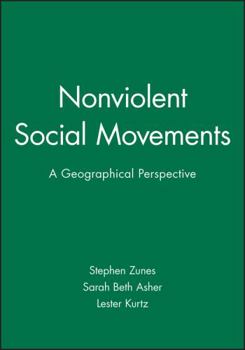< Back to Search Results
Nonviolent Social Movements
Select Format
Select Condition 
Book Overview
Nonviolent Social Movements is the first book to offer a truly global overview of the dramatic growth of popular nonviolent struggles in recent years.
Format:Paperback
Language:English
ISBN:1577180763
ISBN13:9781577180760
Release Date:September 1999
Publisher:Wiley-Blackwell
Length:344 Pages
Weight:1.10 lbs.
Dimensions:1.0" x 6.0" x 9.0"
Customer Reviews
2 ratings
some good material here
Published by Thriftbooks.com User , 20 years ago
Like all anthologies, this is a bit of a mixed bag, but overall it is strong. Even the weaker peices are OK. Some of the essays are just summaries of the history of nonviolent action in some geographical region. Sort of interesting, but I found those pieces to have too much information crammed into too little space. Fortunately, most of the articles are case studies of particular nonviolent campaigns or movements. Some of them are simply narratives--it's not clear what lessons are to be drawn. Most of these case studies analyze the movement or campaign in question in such a way that activists can draw some valuable lessons from them, although in some cases the lessons are left implicit instead of being spelled out, which is kind of annoying. These lessons include both ideas on the application of nonviolent tactics and examinations about how these tactics have diffused from one group or region to another. Finally, there are a few more theoretical pieces, including the conclusion by Zunes and Kurtz, which I thought was the best thing in the book. They critique much nonviolent theory as being overly voluntarist--focusing too much on what social activists do and not enough on how the social and political contexts they are operating create different opportunities and constraints. Zunes and Kurtz argue for a balanced approach that analyzes systems of power and tries to understand how nonviolent activists can best put pressure on them, which is going to differ immensely depending on the larger context. Zunes and Kurtz also examine why nonviolent tactics have increasingly come to be favored over armed struggle--but also the ways in which nonviolent activists have needed to continually innovate as governments have gotten wise and adopted effective means of diffusing the power of nonviolent activism (means that range from making it easy to get permits for marches to paramilitary death squads, depending on geographical region). Overall, this is a valuable source of information on nonviolent movements, what has worked and what hasn't.
nonviolent social movements:a geographical perspectives.
Published by Thriftbooks.com User , 25 years ago
This Book provides an overview of nonviolent movements around the world.It shows how organised nonviolence action can be used as a weopan to bring democracy and to bring social chang. It begins from Africa,from 1919 revolution in Egypt against British occupation to Iranian revolution where opposition leader Khomeni called for non cooperation movement with shah'regime.It also covers nonviolent movements in Palestinian independence struggle against Israeli occupation. In Europe,Grassroots movement in Germany in 1972-1985 using nonviolent action to transform society.Then nonviolent struggle against communist regime in East Europe Hungary,Czekoslavekia,Romania and Baltic states. In Asia,it includes from Phillipines "people power revulution"against dictatorship to Thailand and Burmish revolution against military power. In Africa,nonviolence in anti-apartheid movement in south africa as well as struggle of Ogani people(a distinct ethnic community)of Nigeria for political and environmental rights. In Latin America it focusses on nonviolent struggle against violent oppression by military regimes and organisation of SEPRAJ and other church related institutions. Lastly,In America nonviolent civil rights movement carried out by Martin Luther King jr. It is a very good reference source .






